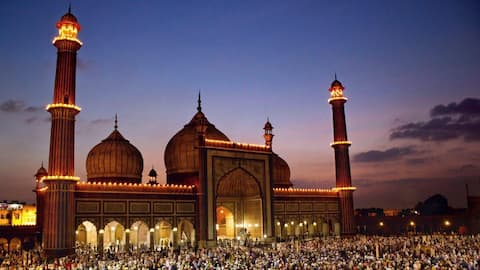Eid Al Adha: Heritage walks to reconnect with India's history
What's the story
Eid al-Adha, the festival of sacrifice, is a time of devotion, reflection, and connection - with faith, family, and history. Beyond prayers and celebrations, it also presents a unique opportunity to explore the rich Islamic heritage woven into the fabric of India's cities. This Eid, why not go beyond rituals and rediscover stories etched in stone, arches, and courtyards?
#1
Old Delhi (Shahjahanabad): Where empires still whisper
Walk through the narrow lanes of Old Delhi and you'll step back into the grandeur of Mughal times. From Jama Masjid, India's largest mosque, to the Red Fort, this walk is an ode to architectural brilliance and spiritual power. The area comes alive during Eid with lights, food stalls, and a palpable festive energy.
#2
Lucknow: The grace of Nawabi legacy
Lucknow's heritage walk is a journey through a city known for its tehzeeb (etiquette) and syncretic culture. The influence of Shia Nawabs is evident in its unique blend of Persian, Awadhi, and Mughal aesthetics. Engage a local historian to understand the deeper significance of Shia customs, especially around Muharram and Eid traditions.
#3
Hyderabad: Of Qutb Shahis and Nizami glory
Hyderabad blends opulence with history in a uniquely southern Islamic narrative. From the Qutb Shahi tombs to Charminar's grandeur, every corner tells stories of an empire that prized learning, trade, and art. Highlights include the iconic Charminar, Mecca Masjid, Qutb Shahi tombs and their serene domes, Chowmahalla Palace's Nizami elegance, and Laad Bazaar's vibrant bangles and fabrics.
#4
Ahmedabad: Sufi Mysticism and Indo-Islamic fusion
Ahmedabad's old city is an underrated gem with a unique blend of Hindu-Muslim architecture. It reflects centuries of coexistence, particularly under the Gujarat Sultanate. Do visit Sidi Saiyyed Mosque and its famed jali work, Rani Sipri Mosque's delicate minarets, and Dada Harir ni Vav (stepwell) that features Arabic calligraphy. The routes offer a look at how Islamic architecture adapted local materials and aesthetics.
#5
Bhopal: Begums, bazaars, and quiet grandeur
Bhopal is one of the few places in the world ruled by Muslim women for over a century. Its monuments, mosques, and man-made lakes make it an enchanting walk through female-led Islamic heritage. Head over to Taj-ul-Masajid (one of Asia's largest mosques), Moti Masjid (built by Sikandar Begum), Shaukat Mahal (with Indo-Gothic features), Sadar Manzil, and the bustling Chowk Bazaar.
